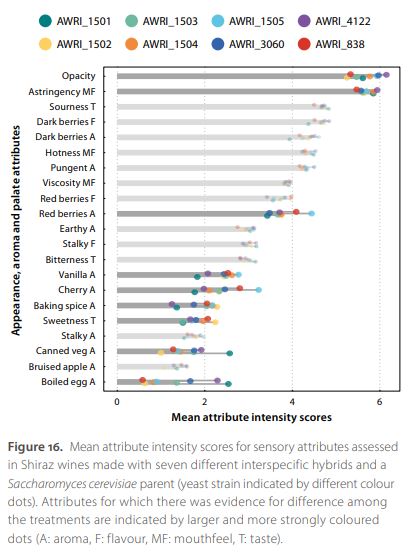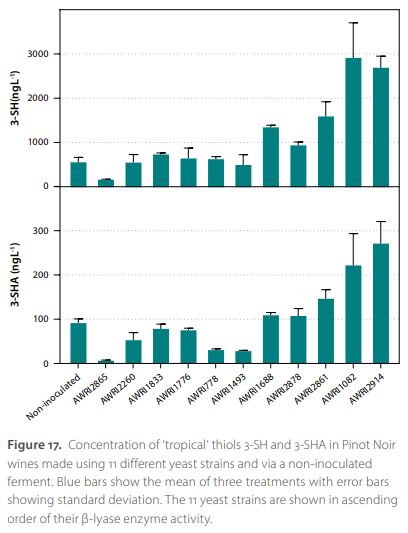Putting microbial diversity to work in shaping wine style
Project summary
The AWRI has a long history in microbial strain development and the successful deployment and commercialisation of newly-developed strains. This project aims to build on that history.
There is substantial scope to both refine existing strains (such as the ‘rose’ yeast and Saccharomyces bayanus hybrids) and optimise their use through varietal or wine style pairing. For example, building on knowledge gained through production of the ‘rose’ yeast, this project will explore the degree to which yeast aromatic profiles can be modulated by modification of carbon flux through amino acid biosynthetic pathways.
Molecular technology will help to determine what is possible, and will provide foundational knowledge on biosynthetic pathways and markers for strain selection. Identification of molecular markers for specific aromatic traits will permit targeted selection of strains isolated during bioprospecting work.
In addition, this project will tap into resources identified in other AWRI projects that have a bioprospecting focus. Novel microorganisms, after initial screening, will be put to work directly through use of appropriate winemaking techniques and/or be used as source material for introducing greater genetic diversity into existing wine strains. Together these breeding and selection strategies will deliver non-genetically modified germplasm that can be used by industry, and will provide new microorganisms for winemakers seeking a point of differentiation in their wines.
Latest information
Hybrid yeast – when one plus one equals three
Interspecific hybridisation is the term used when two different species are mated together. It is a process that the project team has used to introduce genetic diversity into traditional wine yeasts and to harness the traits in more distantly related yeasts – traits that can then be used in winemaking. While the blending of genomes often results in additive combinations of characteristics, occasionally a hybrid may exhibit characteristics different from either parent. One such strain, a hybrid between Saccharomyces cerevisiae and Saccharomyces uvarum, displays robust fermentation properties in high-sugar juices while producing wines with lower concentrations of acetic acid than either parent.

The S. uvarum hybrid discussed above is just one of seven hybrids that have been produced by hybridising a single robust S. cerevisiae strain with each of seven different members of the Saccharomyces clade. How these different hybrid strains ferment red grapes and contribute to red wine’s compositional and sensory qualities was assessed in a vintage trial in 2020, with the wines undergoing sensory descriptive analysis this year (Figure 16). The wines differed across nine descriptive attributes. Key among the more positive attributes were aromas of ‘cherry’, ‘red berry’, ‘baking spice’ and ‘vanilla’. However, some strains produced wines with more prominent ‘boiled egg’ and ‘canned vegetable’ aromas. This work has identified hybrid strains that appear well suited to the production of red wine.
The contribution of Saccharomyces cerevisiae to the extraction and retention of non-volatile components of wine
Macromolecules are known to influence the style and quality of red wine. Wine contains many phenolic substances originating from the grape berry, such as tannins (responsible for the astringency of red wine), anthocyanins (the principal source of red wine colour) and catechins (known for being bitter). Polysaccharides are a chemically diverse group of compounds in wine (derived from both grape and yeast) that affect wine’s mouthfeel and taste. Together, polysaccharides and low molecular weight phenolics influence the sensory perception of astringency, viscosity and hotness in wine. While it is known that the degradation of yeast cell walls contributes to high molecular weight polysaccharides in wine, little is known about yeast’s ability to more broadly influence the macromolecular profile of wine. In particular, the project team has been focusing on whether there are yeast strain-specific contributions to the wine macromolecular profile.
A laboratory-scale red winemaking trial evaluated 93 different wine yeast strains in Shiraz grape juice. Quantitative analyses of the non-volatile components of the resulting wines revealed a wide range of yeast-derived influences on polysaccharide classes, tannin, and anthocyanin concentrations. Future research will investigate the impact of these differences on wine style, particularly whether the magnitude of the differences is sufficient to affect the sensory perceptions of colour and mouthfeel.
Yeast’s effects on varietal thiols in red wine
Varietal thiols such as 3-sulfanylhexan-1-ol (3-SH) and 3-sulfanylhexyl acetate (3-SHA) have been studied extensively in white wines; however, little is known about their formation and sensory impact in reds. The project team screened a group of 15 Saccharomyces cerevisiae strains for their ability to release ‘tropical’ thiols in a Pinot Noir must. There was a marked strain-dependent difference in the varietal thiol concentrations in the resulting wines (Figure 17). What does this reveal about these yeasts? Previous work suggested that moderately high concentrations of thiols are associated with increased ‘red fruit’ character in Pinot Noir and Grenache. Taken together, these studies indicate that some yeasts previously thought of as best suited for white wine production might also be worth considering for the production of some red wines.
Yeast selection for variable higher alcohol production
The aromatic higher alcohols 2-phenylethanol, tryptophol and tyrosol are yeast-derived compounds that modulate the aroma and palate of fermented beverages such as beer, wine and sake. A group of five variants of the widely used industrial wine strain AWRI 796, previously isolated due to their elevated production of the desirable ‘rose’-like aroma compound 2-phenylethanol, were characterised in pilot-scale fermentations of a Chardonnay must. Results showed that these variants increased both the concentration of 2-phenylethanol and modulated the formation of the higher alcohols tryptophol, tyrosol and methionol, in addition to volatile sulfur compounds derived from the amino acid methionine. This work highlights the connections between nitrogen and sulfur metabolism in yeast during fermentation.
The team also monitored the evolution of higher alcohols during wine ageing (storage), focusing on the sulfonation of tryptophol, which yields tryptophol-2-sulfonate, a compound that has been linked with bitterness in wine. The formation of tryptophol-2-sulfonate stabilised after six months in bottle. Longer storage time did not lead to further increases in the concentration of this compound. Sensory analysis of the Chardonnay wines showed that both tryptophol and tryptophol-2-sulfonate were associated with decreased ‘sweetness’, and a low level of ‘bitter taste’. Conversely, in sparkling wines made using strains with a moderate tryptophol-producing phenotype, no significant conversion into the sulfonated form was observed after approximately ten months in bottle. The incomplete conversion of tryptophol to tryptophol-2-sulfonate suggests that the reaction might depend on the physico-chemical characteristics of the wine, such as pH, temperature, SO2 concentration and O2 concentration.
Project Contact
Simon Schmidt, Anthony Borneman

